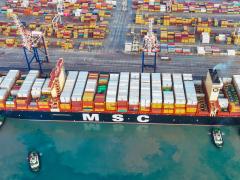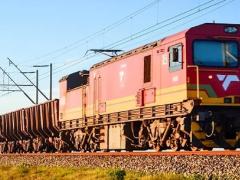Cape Town Container Terminal (CTCT) is on the verge of completing the commissioning process for the first nine new rubber-tyred gantry (RTGs) cranes ordered from Liebherr, the component parts of which arrived in May, Freight News has been reliably informed.
A port insider, who spoke on condition of anonymity, said the cranes should be put into service as early as Monday or Tuesday.
Whereas assembly and assessment by the original equipment manufacturer can take up to six weeks, or about four-and-half to five months if nine new cranes are simultaneously operationalised, Liebherr Africa and Transnet Port Terminals (TPT) have fast-tracked the process.
The source said it underscored the urgency of bringing the new RTGs into action at the port.
Moreover, a general cargo vessel carrying component parts for a second batch of new RTGs was imminently expected at the port, the source said.
This information was verified using MagicPort vessel tracking, which located the BBC Peru halfway down the West Coast at noon on July 3.
Its estimated arrival time was reported as 20:00 local time.
It is understood that TPT is keeping berth 604 at CTCT open to work the vessel, and the offloading of the new equipment might be completed by Saturday.
However, bad weather continues to hamper ship-to-shore throughput, the South African Association of Freight Forwarders (Saaff) and Business Unity SA have found in its port update.
But stakeholders remained optimistic, said Dr Jacob van Rensburg, head of Research and Development at Saaff.
Speaking ahead of the first-ever visit of an ultra-large container vessel to local shores, scheduled to call at the Port of Ngqura, the Container Movement Update (CMU) stated: “Following two strong weeks of container throughput, optimism is building, as Ngqura prepares to receive the 24 000 TEU MSC Nicola Mastro.”
Earlier this week the CMU reported that, for June 22 and 29, local ports handled over 97 000 and 87 000 twenty-foot equivalent units respectively.
These figures heralded concurrent increases of 13% and 2% above target, Saaff said.
“Things are certainly looking up for our ports,” the source said, “especially for Durban.
“In Cape Town it’s going to take a little longer to record figures similar in strength of recovery, but that’s obviously why CTCT seems to be pushing for the new RTGs.
“We don’t see as many at anchor as we used to but it’s not necessarily a good thing. Our port authorities know that volume is an issue and they seem to be doing whatever they can to improve capacity.”
The source said Cape Town’s RTG fleet should consist of at least 28 machines but is operating at about 19-22.
With the new RTGs coming into operation, it is expected that the nine older machines, prone to breaking down, will be decommissioned and cannibalised for spare parts where possible.
At the time the cranes were procured, Western Cape Terminals managing executive, Oscar Borchards, said the new RTGs were ideal for gusty conditions, capable of remaining operational in winds of up to 90 kilometres an hour thanks to anti-sway technology.
Older equipment can’t be operated above 70 km p/hr.
At the time of preparing this post, TPT was said to be drafting an official statement about the RTGs at CTCT.













